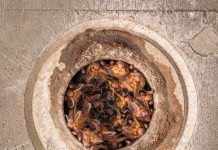The Santa Clara Valley Water District is angling for $750,000 in
federal money to perform a series of research projects and studies
on the perchlorate contamination in South County.
The Santa Clara Valley Water District is angling for $750,000 in federal money to perform a series of research projects and studies on the perchlorate contamination in South County.
The biggest project is the district’s effort to determine the source of the so-called northeast flow, which moves north of the site of the Olin Corp.’s former road-flare factory in Morgan Hill. The company has taken responsibility for the 9.5 mile plume flowing south and east of the site, but claims its own research rules out the factory as the source of the northern contamination.
Last year, the Central Coast Regional Water Resources Control Board ordered Olin to perform additional tests, employing a new forensic testing method. Olin resisted, and to avoid a legal battle, the district agreed earlier this year to conduct the tests.
Forensic testing works by distinguishing different sources of contamination based on characteristics of chemicals released. Perchlorate has a variety of sources, including some fertilizers, rocket fuel and road flares.
The road flares produced by Olin were made primarily of strontium nitrate that occurred in higher concentrations than perchlorate. Water contaminated with perchlorate from that site may also test positive for strontium nitrate and other chemicals with the same properties as those used in the flares. Water District Perchlorate Project Manager Tom Mohr, who will oversee the tests, said that while forensic testing is not a magic bullet it may add substantially to the weight of evidence supporting one scenario over another.
The district also wants to evaluate new methods of cleaning the groundwater by potentially changing the way water flows from the Llagas creek into the percolation ponds that recharge the Llagas groundwater basin. A third grant proposal the district will submit this month is for additional staff for the district, the regional board, and the Santa Clara County Health Department.
Tracy Hemmeter, a senior project manager with the district, said the studies are all aimed at gathering information about perchlorate to facilitate cleanup of the groundwater basin.
“The projects are designed to meet our needs and the community’s needs,” Hemmeter said. “The challenge now is working with the [Environmental Protection Agency] to work out the details.”
The grant applications give the district access to money that has already been set aside in the federal budget. The district will submit a future round of applications for an additional $1 million that has been earmarked for studying perchlorate in Santa Clara County. Mohr hopes to begin testing the northeast flow later this year. Olin must submit a final cleanup plan for the groundwater basin by June 2006.







